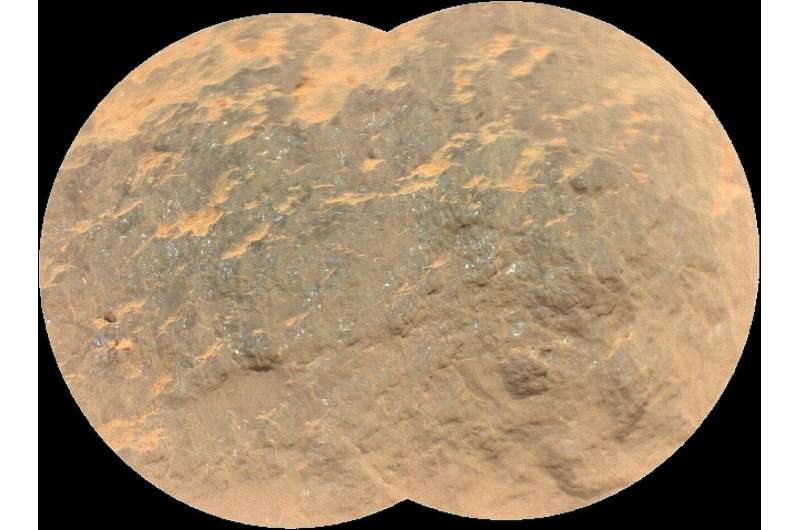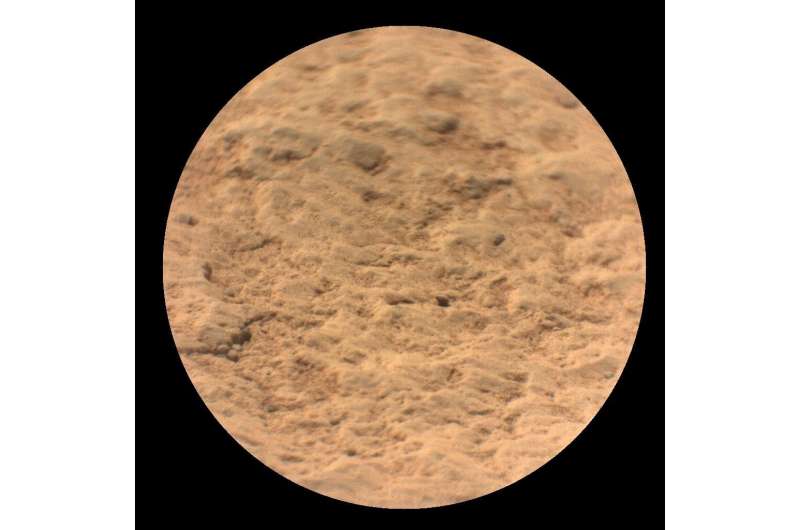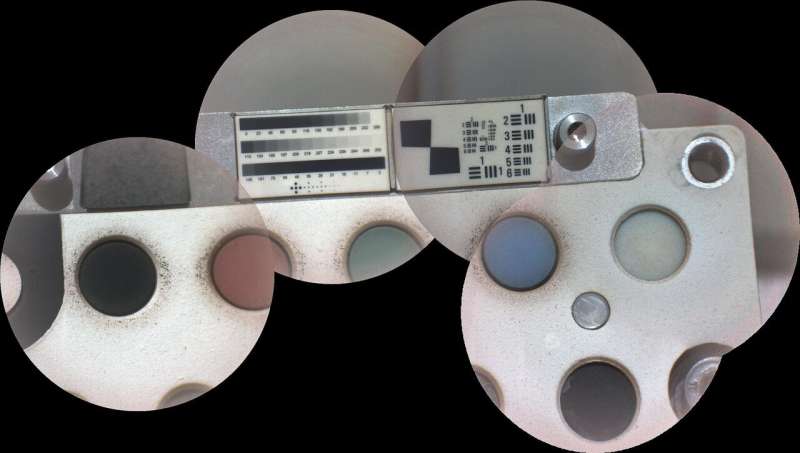Science
Perseverance rover's SuperCam science instrument delivers first results – Phys.org

The first readings from the SuperCam instrument aboard NASA’s Perseverance rover have arrived on Earth. SuperCam was developed jointly by the Los Alamos National Laboratory (LANL) in New Mexico and a consortium of French research laboratories under the auspices of the Centre National d’Etudes Spatiales (CNES). The instrument delivered data to the French Space Agency’s operations center in Toulouse that includes the first audio of laser zaps on another planet.
“It is amazing to see SuperCam working so well on Mars,” said Roger Wiens, the principal investigator for Perseverance’s SuperCam instrument from Los Alamos National Laboratory in New Mexico. “When we first dreamed up this instrument eight years ago, we worried that we were being way too ambitious. Now it is up there working like a charm.”
Perched atop the rover’s mast, SuperCam’s 12-pound (5.6-kilogram) sensor head can perform five types of analyses to study Mars’ geology and help scientists choose which rocks the rover should sample in its search for signs of ancient microbial life. Since the rover’s Feb. 18 touchdown, the mission has been performing health checks on all of its systems and subsystems. Early data from SuperCam tests—including sounds from the Red Planet—have been intriguing.
“The sounds acquired are remarkable quality,” says Naomi Murdoch, a research scientist and lecturer at the ISAE-SUPAERO aerospace engineering school in Toulouse. “It’s incredible to think that we’re going to do science with the first sounds ever recorded on the surface of Mars!”


On March 9, the mission released three SuperCam audio files. Obtained only about 18 hours after landing, when the mast remained stowed on the rover deck, the first file captures the faint sounds of Martian wind.
“I want to extend my sincere thanks and congratulations to our international partners at CNES and the SuperCam team for being a part of this momentous journey with us,” said Thomas Zurbuchen, associate administrator for science at NASA Headquarters in Washington. “SuperCam truly gives our rover eyes to see promising rock samples and ears to hear what it sounds like when the lasers strike them. This information will be essential when determining which samples to cache and ultimately return to Earth through our groundbreaking Mars Sample Return Campaign, which will be one of the most ambitious feats ever undertaken by humanity.”


The SuperCam team also received excellent first datasets from the instrument’s visible and infrared (VISIR) sensor as well as its Raman spectrometer. VISIR collects light reflected from the Sun to study the mineral content of rocks and sediments. This technique complements the Raman spectrometer, which uses a green laser beam to excite the chemical bonds in a sample to produce a signal depending on what elements are bonded together, in turn providing insights into a rock’s mineral composition.
“This is the first time an instrument has used Raman spectroscopy anywhere other than on Earth!” said Olivier Beyssac, CNRS research director at the Institut de Minéralogie, de Physique des Matériaux et de Cosmochimie in Paris. “Raman spectroscopy is going to play a crucial role in characterizing minerals to gain deeper insight into the geological conditions under which they formed and to detect potential organic and mineral molecules that might have been formed by living organisms.”
Citation:
Perseverance rover’s SuperCam science instrument delivers first results (2021, March 11)
retrieved 11 March 2021
from https://phys.org/news/2021-03-perseverance-rover-supercam-science-instrument.html
This document is subject to copyright. Apart from any fair dealing for the purpose of private study or research, no
part may be reproduced without the written permission. The content is provided for information purposes only.
Science
Giant prehistoric salmon had tusk-like teeth for defence, building nests


|
|
The artwork and publicity materials showcasing a giant salmon that lived five million years ago were ready to go to promote a new exhibit, when the discovery of two fossilized skulls immediately changed what researchers knew about the fish.
Initial fossil discoveries of the 2.7-metre-long salmon in Oregon in the 1970s were incomplete and had led researchers to mistakenly suggest the fish had fang-like teeth.
It was dubbed the “sabre-toothed salmon” and became a kind of mascot for the Museum of Natural and Cultural History at the University of Oregon, says researcher Edward Davis.
But then came discovery of two skulls in 2014.
Davis, a member of the team that found the skulls, says it wasn’t until they got back to the lab that he realized the significance of the discovery that has led to the renaming of the fish in a new, peer-reviewed study.
“There were these two skulls staring at me with sideways teeth,” says Davis, an associate professor in the department of earth sciences at the university.
In that position, the tusk-like teeth could not have been used for biting, he says.
“That was definitely a surprising moment,” says Davis, who serves as director of the Condon Fossil Collection at the university’s Museum of Natural and Cultural History.
“I realized that all of the artwork and all of the publicity materials and bumper stickers and buttons and T-shirts we had just made two months prior, for the new exhibit, were all out of date,” he says with a laugh.
Davis is co-author of the new study in the journal PLOS One, which renames the giant fish the “spike-toothed salmon.”
It says the salmon used the tusk-like spikes for building nests to spawn, and as defence mechanisms against predators and other salmon.
The salmon lived about five million years ago at a time when Earth was transitioning from warmer to relatively cooler conditions, Davis says.
It’s hard to know exactly why the relatives of today’s sockeye went extinct, but Davis says the cooler conditions would have affected the productivity of the Pacific Ocean and the amount of rain feeding rivers that served as their spawning areas.
Another co-author, Brian Sidlauskas, says a fish the size of the spike-toothed salmon must have been targeted by predators such as killer whales or sharks.
“I like to think … it’s almost like a sledgehammer, these salmon swinging their head back and forth in order to fend off things that might want to feast on them,” he says.
Sidlauskas says analysis by the lead author of the paper, Kerin Claeson, found both male and female salmon had the “multi-functional” spike-tooth feature.
“That’s part of our reason for hypothesizing that this tooth is multi-functional … It could easily be for digging out nests,” he says.
“Think about how big the (nest) would have to be for an animal of this size, and then carving it out in what’s probably pretty shallow water; and so having an extra digging tool attached to your head could be really useful.”
Sidlauskas says the giant salmon help researchers understand the boundaries of what’s possible with the evolution of salmon, but they also capture the human imagination and a sense of wonder about what’s possible on Earth.
“I think it helps us value a little more what we do still have, or I hope that it does. That animal is no longer with us, but it is a product of the same biosphere that sustains us.”
This report by The Canadian Press was first published April 24, 2024.
Brenna Owen, The Canadian Press





Science
Giant prehistoric salmon had tusk-like spikes used for defence, building nests: study


|
|
A new paper says a giant salmon that lived five million years ago in the coastal waters of the Pacific Northwest used tusk-like spikes as defense mechanisms and for building nests to spawn.
The initial fossil discoveries of the 2.7-metre-long salmon in Oregon in the 1970s were incomplete and led researchers to suggest the fish had fang-like teeth.
The now-extinct fish was dubbed the “saber-tooth salmon,” but the study published in the peer-reviewed journal PLOS One today renames it the “spike-toothed salmon” and says both males and females possessed the “multifunctional” feature.
Study co-author Edward Davis says the revelation about the tusk-like teeth came after the discovery of fossilized skulls at a site in Oregon in 2014.
Davis, an associate professor in the department of earth sciences at the University of Oregon, says he was surprised to see the skulls had “sideways teeth.”
Contrary to the belief since the 1970s, he says the teeth couldn’t have been used for any kind of biting.
“That was definitely a surprising moment,” Davis says of the fossil discovery in 2014. “I realized that all of the artwork and all of the publicity materials … we had just made two months prior, for the new exhibit, were all out of date.”





Science
SpaceX sends 23 Starlink satellites into low-Earth orbit


|
|
April 23 (UPI) — SpaceX launched 23 Starlink satellites into low-Earth orbit Tuesday evening from Space Launch Complex 40 at Cape Canaveral Space Force Station in Florida.
Liftoff occurred at 6:17 EDT with a SpaceX Falcon 9 rocket sending the payload of 23 Starlink satellites into orbit.
The Falcon 9 rocket’s first-stage booster landed on an autonomous drone ship in the Atlantic Ocean after separating from the rocket’s second stage and its payload.
The entire mission was scheduled to take about an hour and 5 minutes to complete from launch to satellite deployment.
The mission was the ninth flight for the first-stage booster that previously completed five Starlink satellite-deployment missions and three other missions.





-



 Health21 hours ago
Health21 hours agoRemnants of bird flu virus found in pasteurized milk, FDA says
-
Art21 hours ago
Random: We’re In Awe of Metaphor: ReFantazio’s Box Art
-
News17 hours ago
Amid concerns over ‘collateral damage’ Trudeau, Freeland defend capital gains tax change
-
Art15 hours ago
The unmissable events taking place during London’s Digital Art Week
-
Tech22 hours ago
Surprise Apple Event Hints at First New iPads in Years
-
Science20 hours ago
NASA hears from Voyager 1, the most distant spacecraft from Earth, after months of quiet
-



 Politics19 hours ago
Politics19 hours agoHow Michael Cohen and Trump went from friends to foes
-
Media21 hours ago
Vaughn Palmer: B.C. premier gives social media giants another chance





